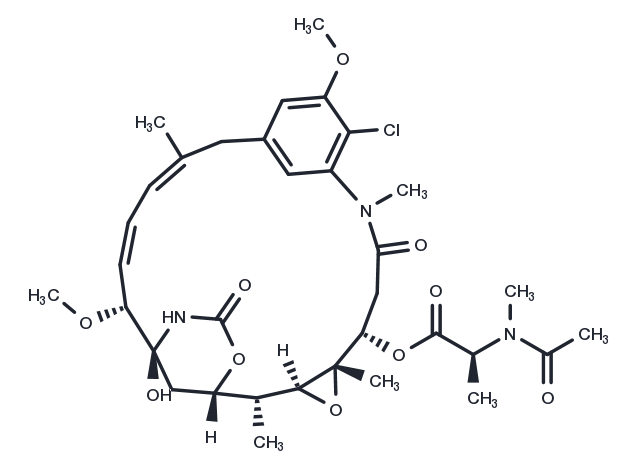Powder: -20°C for 3 years | In solvent: -80°C for 1 year


Maytansine (NSC-153858), an ansamycin antibiotic originally isolated from the Ethiopian shrub Maytenus serrata, inhibits the assembly of microtubules by binding to tubulin at the rhizoxin binding site.

| Pack Size | Availability | Price/USD | Quantity |
|---|---|---|---|
| 5 mg | In stock | $ 59.00 | |
| 10 mg | In stock | $ 98.00 | |
| 25 mg | In stock | $ 238.00 | |
| 50 mg | In stock | Inquiry | |
| 1 mL * 10 mM (in DMSO) | In stock | $ 92.00 |




| Description | Maytansine (NSC-153858), an ansamycin antibiotic originally isolated from the Ethiopian shrub Maytenus serrata, inhibits the assembly of microtubules by binding to tubulin at the rhizoxin binding site. |
| Synonyms | NSC-153858, NSC153858, Maitansina, NSC 153858, Maitansine |
| Molecular Weight | 692.2 |
| Formula | C34H46ClN3O10 |
| CAS No. | 35846-53-8 |
Powder: -20°C for 3 years | In solvent: -80°C for 1 year
H2O: Insoluble
DMSO: 60 mg/ml (86.68 mM)
You can also refer to dose conversion for different animals. More
bottom
Please see Inhibitor Handling Instructions for more frequently ask questions. Topics include: how to prepare stock solutions, how to store products, and cautions on cell-based assays & animal experiments, etc.
Maytansine 35846-53-8 Cytoskeletal Signaling Microbiology/Virology Microtubule Associated Antibiotic NSC-153858 Microtubule/Tubulin tumor mitotic microtubule-targeted arrest NSC153858 Maitansina Inhibitor NSC 153858 potent subnanomolar Maitansine inhibit inhibitor
